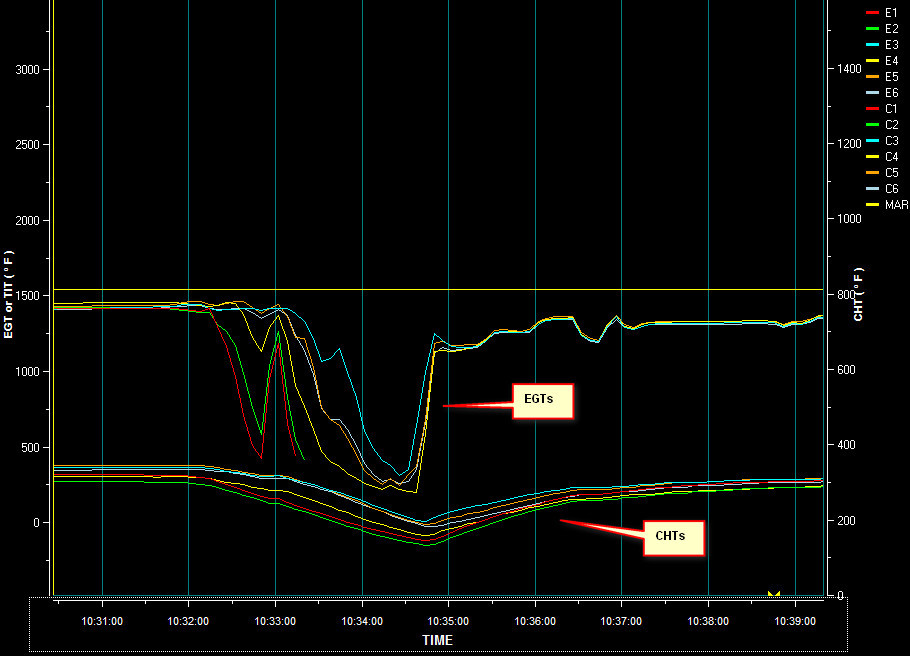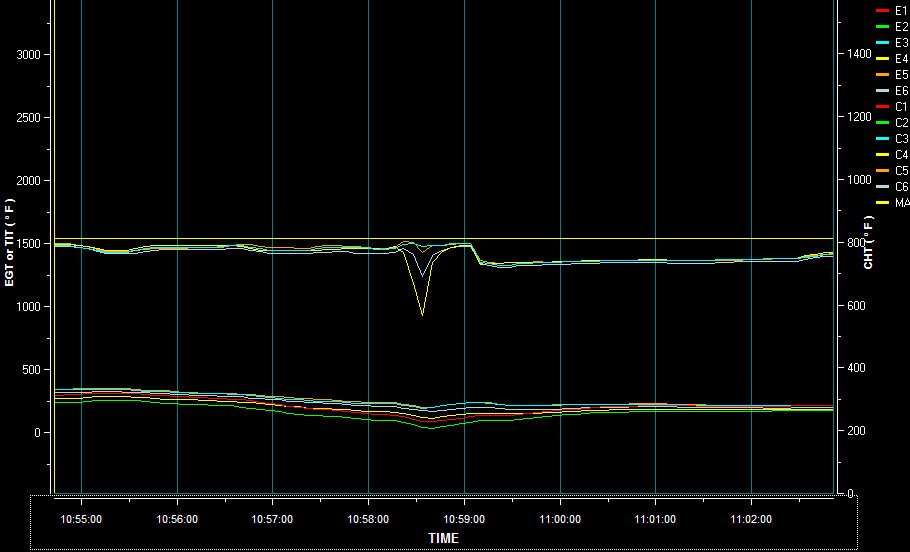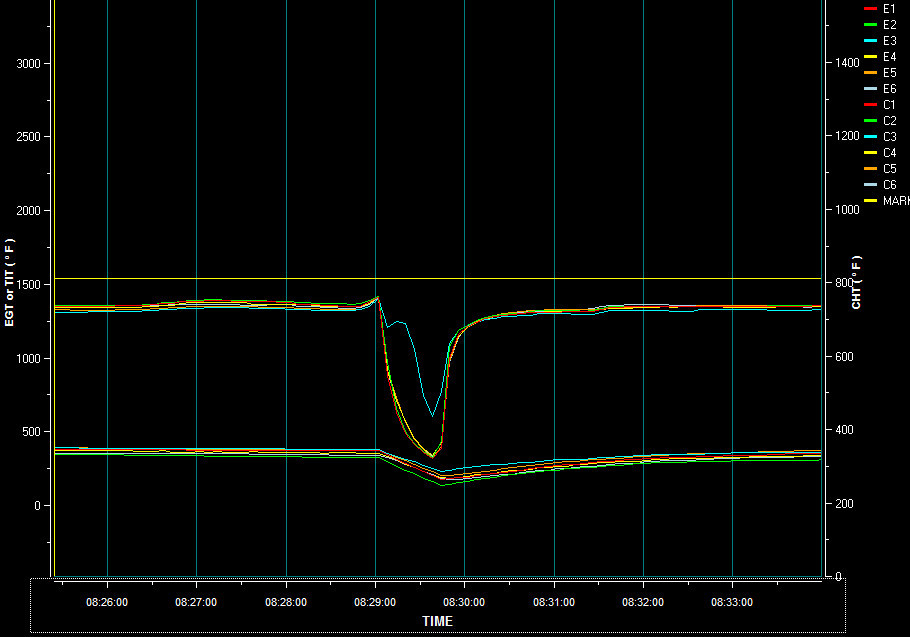I have a carb temp gauge with a yellow arc where icing is possible. Due to the turbo, I’m practically never in that area. I’m sure a fuel servo temp sensor would serve the same purpose. As you said: icing can happen in the fuel servo just like it can happen in the carb, the latter just has the added “benefit” of lowering the temperature due to the venturi effect so you end up with icing when nothing outside suggests it could be a danger.
Icing is usually possible in a rather narrow temperature band. Applying alternate air changes the temperature enough to no longer be in that range. I assume this is how it works.
That, surely, is a good reason to not fly with the alternate air always open (icing conditions or not). Same with carb heat – there are temp/DP scenarios where having the carb heat open will take you into the icing region in the venturi.
The fix is to immediately use the alternate air door.
What if you have an automatic alternate air door? I assume it won’t open because there wouldn’t be a drop of pressure in the air intake.
Yes – an alternate air door will not open if the engine has stopped sucking in air. However, it will suck all the time it is rotating, including windmilling.
Whether the manufacturer has got the spring strength correct for the windmilling scenario (say 700rpm) is a good question 
Also, if the air intake is blocked, it will take much more power to windmill the engine, so if you don’t keep your speed up during an engine failure due to intake icing the engine could just stop and then you have a lot more work to do.
The equipment used here would easily settle the question of whether the alternate air is warm enough.
Event #1 – FL160 -13C peak EGT The overall length of the event is about 2 minutes! The alternate air was pulled within 5 seconds of the first abnormal EDM700 indication but luckily there was about 13000ft of terrain clearance. However the engine did produce some power much of that time. The wild fluctuation in some of the EGTs caused the EDM700 to shut down two of the EGT probes, for the rest of the flight. This is a good reason for having a switch or a CB just for that instrument. The fluctuations were also very distracting, looking like something had come off the engine.

Event #2 – FL080 -5C peak EGT This was later on the same flight, in the descent to an ILS, and with the alternate air already pulled from the previous event! The higher EGTs are a result of flying lower. This one was very brief – only a few seconds. It cleared by itself and anyway nothing could be done about it. The interesting thing is that the CHTs start gradually dropping over 2 minutes before the sudden dip in the EGTs. The probable reasons could be me gradually enriching the mixture in the descent, or flying in denser moisture which would have a greater cooling effect on the engine. This event could have been caused by some residual ice lying around from Event #1 and getting sucked into the fuel servo… it was noticed that at Event #1 the alternate air door was quite stiff.

Event #3 – FL170 -16C 130F ROP Coincidentally I was watching the EDM700 at the instant the EGTs started to rise. The appearance was exactly what you would expect if leaning the mixture from the 130F ROP to peak EGT, over maybe 10 seconds. I was watching the instrument with much interest – until the EGTs suddenly fell and then I pulled the alternate air and put on the electric fuel pump immediately. On this occasion the engine was not producing any real power, though cylinder 6 seems to have been. If the alternate air did it, it took about 40 seconds to have an effect!

I am putting this online in case it helps somebody. I am not convinced that there is a simple solution, and it may well be that the use of propeller TKS does the job, because I have flown in -5C many times without any problems. Well, airframe icing is more or less guaranteed at -5C eventually, but never had any engine issues, and never used alternate air.
Why would it happen 3 times on one flight at different altitudes and temperatures?
Are you sure there is nothing else wrong? I would also expect a more gradual degradation in power and not a sudden loss of power with then goes away suddenly. My feeling is that there is something else wrong.
2 on one flight, the 3rd one 1 year earlier.
The fuel servo, the engine fuel pump and some other stuff were changed after #3. Nothing was found in the returned items, though the fuel lab test showed the gum content was 10x out of spec and there was a small amount of water droplets on the bottom of the container. There was also a strange grey deposit on the main fuel filter (80-100 micron mesh; < 1% was obscured) which I had electron microscope analysed and they thought it was talcum powder but they could not really tell…
The common factor is flight in IMC, and the temperatures. In VMC, wide range of temps down to -38C, no issue ever. As I almost never fly in solid IMC at say -15C (VMC on top is my usual mode) this connection is significant.
The TB20 POH requires you to use alternate air at all times when icing is possible. You don’t follow that procedure?
I did not find the German accident report on the TB20 in Munich that had intake icing but I found some references to it in forums. It must be somewhere on the BFU web site…
Probably, using alternate air is a good idea. It does however mean that if you get icing, there is nothing you can do except descend into warm enough air.
I also think that a simple ice buildup on the air intake is not going to cause this. It would have the same effect as closing the throttle, and closing the throttle definitely does not bring down the fuel flow like that.
The very basic point here is that in the 13 years and 1600hrs I have done in this plane, all over Europe, I have done only two flights where I was in solid IMC (for more than a few mins) around the -13C to -16C region and was not using prop TKS. And I had this funny business on both of them!
Normally, any IMC flight between -1C and -8C means virtually assured airframe icing and it’s only a matter of time before you see it build up. So I don’t do that sort of flying except for a few minutes, to climb up or down. And, always, no alternate air, and always, prop TKS on MAX. Never had any engine issue.
I have been down to -20 to -30C countless times, for hours, and once or twice down to -38C and again no issue whatever. But only in VMC.
I have done a few flights where I was in haze (sun sort of visible above) at say -15C to -20C, for hours, and nothing happened on those. But normally I would have used TKS, just in case, on the LOW setting. The #1 event flight had a ~2hr portion like that. It was only later when we got into solid IMC that the engine issue started, after maybe 10-20 mins.
To me, this is way too much of a coincidence. Out of 1600hrs, only two flights which had extended IMC periods in about -15C, and get this on both of them. It has to be an icing issue, in the air path. Nothing makes any sense!
On the last flight, the alternate air door was hard to open initially (as if glued in position) and that must have been ice, and it must have been inside the air duct, right behind the air filter. The plane had an Annual recently and the cables were lubed. I do an owner assisted Annual, with a very good A&P/IA, and go around everything myself. No way do I trust any maintenance company anymore. Been there, done that, had controls freeze up at -15C due to some nameless gunk squirted in there. So everything is done 100% right and I personally do it or supervise it.
That means that the water particles which froze up inside the inlet duct must have passed through the Brackett foam filter (the sort which has the sticky glue in it).
And, absolutely crucially, that in turn means that had I been using prop TKS at that time (despite the -13C OAT not apparently needing it because in non convective cloud structural icing at -13C is almost impossible and indeed the wings were totally clean, not to mention the much higher TAS of the prop blades) the TKS fluid would have also got through the air filter and would have prevented ice buildup in there. There is a lot of TKS fluid involved – the TKS spray from the prop covers the front window so effectively that you can have 1" of ice on the wings (don’t ask me how I know) but the window remains clear. So, prop TKS floods the intake duct pretty effectively.
The aircraft POH recommends using alternate air in icing conditions but I don’t believe that’s the whole story because that just ingests “somewhat” warmed up air, and will work only if that air is always above 0C even if the OAT is at the lowest possible value which for this aircraft is -38C based on an actual flight. Will the air passing through the engine really warm by 38K in all cases? Even at say 40% power? Somehow I doubt that anybody has actually done that measurement… it’s not the sort of thing somebody would be concerned with once their POH is FAA and DGAC approved. But it’s an easy measurement to make because the air duct is easy to attach a PT100 probe to.
Does somebody know how to do a rough calculation of the expected temp rise of air, impacting the two cowling holes of say 150×100mm, 150kt TAS, and passing through an engine dissipating ~40kW into the air? Only about 12% of the heat generated is lost to the air (ref here). I guess it will be far easier to work it out empirically 
This is applicable to any aircraft using these engines, not just a TB20.
Incidentally, the prop TKS fluid which enters the ~50mm heater inlet hole at the front also ends up in the cockpit, having been nicely baked in the heater…